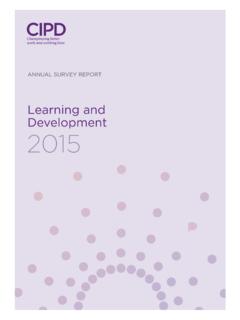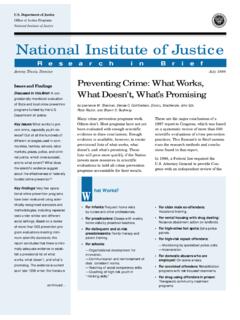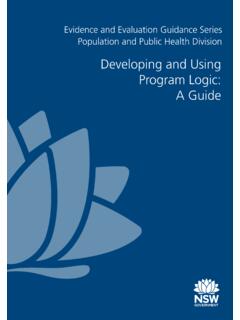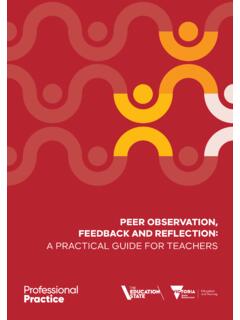Transcription of Critical Thinking and Writing for Nursing Students
1 EXAMPLE ESSAYS FOR. Critical Thinking and Writing for Nursing Students Bob Price and Anne Harrington CONTENTS: Example analytical essay - page 1. Example reflective essay - page 11. EXAMPLE ANALYTICAL ESSAY. This example of an analytical essay is presented in association with Price, B and Harrington, A (2010). Critical Thinking and Writing for Nursing Students , Exeter, Learning Matters. Readers are introduced to the process of Critical and reflective Thinking and the translation of these into coursework that will help them to achieve better grades in Nursing courses. Stewart, Raymet, Fatima and Gina are four Students who share their learning journey throughout the chapters of the book. In this essay on the evaluation of different sorts of evidence, Stewart demonstrates his Writing skills near the end of his course.
2 Stewart was set the task of evaluating different sorts of evidence within Nursing and making a case regarding how the nurse might proceed. At the end of the essay we offer notes that explain the Critical Thinking and Writing features of Stewart's work. Remember, copying essays such as this, submitting them as a whole or in part for assessment purposes, without attributing the source of the material, may leave you open to the charge of plagiarism. Significant sanctions may follow for nurses who do this, including referral to the Nursing and Midwifery Council. Evaluating evidence in Nursing For reasons of patient safety and the improvements in the quality of healthcare, nurses are urged to base their practice on evidence (Barker, 2009).
3 Evidence too may be argued as a basis for arranging the most cost effective care, using limited resources to best effect. I define evidence here as consisting of that information that the nurse can point to as authoritative, being more than simple opinion or predilection to practice in a particular way. In practice, the availability of evidence may be limited, some evidence may contradict other evidence and the nurse must therefore make judgements about what is found (Jolley, 2009). It is necessary to note that different sorts of evidence may be used to different purpose. For example, evidence of how patients experience illness can tell the nurse about how patients feel and what matters most to them. It cannot guide the nurse on what sorts of care are most effective.
4 Statistical evidence, especially that originating from robust experiments, might help the nurse to determine what causes a particular effect and to decide whether to arrange care differently. Not all evidence is the same then, some is more powerful than others, and a fit between evidence and practice 1. needs to be determined (Brotchie et al, 2010). In this paper I first review the different types of evidence that may be available to the nurse. I. then use the work of Proctor and Rosen (2004) to highlight possible fits between evidence and efforts to improve practice. The third part of this paper summarises points about how best to judge the different evidence available the criteria to be used will differ, dependent on the evidence considered.
5 I argue the case that the nurse evaluates evidence well where he or she understands the nature of the evidence, establishes where that evidence might serve well and makes wise judgements on the authority, completeness and coherence of the evidence available. Types of evidence Whilst evidence can be classified in different ways, I suggest here that it is useful to make distinctions between research and experiential evidence in the first instance and then within research evidence to note that there are different research designs that affect the nature of evidence presented. It may seem contentious to think of experience as a form of evidence, but in practice it is frequently called upon as just that ( Finlay, 2009; Beam et al, 2010).
6 At its weakest, groups of nurses develop a working impression of how patients cope, how care is delivered and what consequences emerge if Nursing is delivered in particular ways. In my experience, nurses might refer to this as practice wisdom, a collective know how that seems to work well with given groups of patients. Such evidence provides at best a first impression, and overview of issues. It is enhanced where the nurse plans reflection and observation more carefully, with reference to particular questions and focusing perhaps on case studies that allow matters to be mapped and discussed (Leach, 2007). It increases stature, as evidence, to the degree that information is gathered in a disciplined and organised way, and with a stated purpose in mind.
7 That experiential evidence is important in healthcare is important is illustrated by the analysis of case studies in care and especially those associated with risk management ( Stewart, 2010). Nurses and others may analyse cases in some depth to establish what went wrong, what was missed or misinterpreted, all with the aim of avoiding mistakes and of improving performance in the future. The more familiar form of evidence that most colleagues refer to when discussing evidence based practice is that which emerges from research (Barker, 2009). Research produces evidence precisely because of the disciplined way in which enquiries are arranged and the efforts made to gather data that attend to the aims, questions or hypotheses of the research project.
8 Designs are influential here. Research that has been designed within the positivist tradition works assiduously to remove the risk of researcher bias and to gather sufficient data of the right type to make claims about a population of people. There is an emphasis upon impartial enquiry, with the researcher arranging checks by others such as Critical reviewers to ensure that assumptions are not prematurely made about what is found (Grix, 2004). Other research is conducted within the naturalistic or interpretive tradition ( phenomenology, grounded theory, some forms of ethnography) and here the work proceeds differently. The researcher argues that it is more important to conduct work that is authentic to healthcare, than to conduct a study that has excluding all possible forms of bias (Silverman, 2004).
9 The goal of such research is often to help others portray their experience of health, illness or care and to help 2. nurses understand what patients and others might need or hope for (Brotchie et al, 2010). The researcher might suggest that it is impossible to completely disassociate themselves from perspectives or views that could shape the line of enquiry. A third research design may be described as Critical theory (Swartz, 1997). The researcher starts with acknowledged goals to correct inequalities in health or care and to make a case for the disadvantaged. Feminist research for example acknowledges that the researcher will not stand dispassionately aside when deliberating on what needs to be discovered or how evidence might support a case for change.
10 Sometimes naturalistic and Critical theory research is grouped together as qualitative research'. because they often produce qualitative data and in contrast to the quantitative data that sometimes emerges from positivist research (Green and Thorogood, 2009). What seems significant in this overview of different research designs, is that there is no universally agreed goal of research, nor is the evidence produced all of one sort. Researchers adopt different roles depending on the design of research used. In positivist research the role of the researcher is typically described as dispassionate and they proceed to gather information from outside the experience of others (it is described as etic'). In naturalistic and Critical theory research the researcher often approaches their subject much more closely, intimately, for example observing and interviewing as a participant in the situation explored (it is described as emic') (Brotchie et al, 2010).














